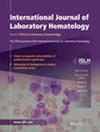Evaluation of Clauss Fibrinogen Assay Clot Waveform Analysis for the Detection of Dysfibrinogenemia on Sysmex CN-6000
Abstract
Introduction
Dysfibrinogenemia is associated with thrombosis and bleeding. Identification is important as it correlates with adverse clinical outcomes. Clot waveform analysis (CWA) measures optical changes during clot formation to generate a clot waveform curve. Mathematical interpretation allows for the determination of velocity through the first derivative (Min1). Clauss Fibrinogen (CF) Min1 correlates with fibrinogen antigen (FbAg) levels. After calibration, estimated fibrinogen antigen (eAg) can be calculated. Studies have established a ratio of functional fibrinogen activity (FbAc) to eAg (FbAc/eAg) threshold of 0.7 effective for identifying dysfibrinogenemia.
Methods
Samples were analysed by CN-6000 (Sysmex) for PT-derived fibrinogen, Thrombin and Reptilase Times, CF (Dade Innovin, Thromboclotin, Baxotrobin and Dade Thrombin respectively, Siemens) and FbAg (Liaphen Fibrinogen, Hyphen), along with CF-CWA. The effectiveness of eAg for quantifying fibrinogen was compared to traditional FbAg measurements, along with the efficacy of FbAc/eAg in identifying dysfibrinogenemia relative to the classical FbAc/Ag ratio.
Results
Strong correlations between FbAg and eAg were evident in normal (R 2 0.9559) and hypofibrinogenemic (R 2 0.9119) cohorts; however, a weak correlation was observed in dysfibrinogenemic cohorts (R 2 0.3987). In the dysfibrinogenemic cohort, modification of the test dilution for calculating eAg was assessed; however, these changes did not enhance correlation. eAg values by both dilutions did not impair the ability of the FbAc/eAg ratio to distinguish dysfibrinogenemia from normal and hypofibrinogenemia cohorts, proving as effective as the FbAc/Ag ratio.
Conclusion
Our results endorse the reliability of the FbAc/eAg ratio as a cost-effective parameter for identifying dysfibrinogenemia, despite eAg quantification limitations in dysfibrinogenemia cases.

 求助内容:
求助内容: 应助结果提醒方式:
应助结果提醒方式:


